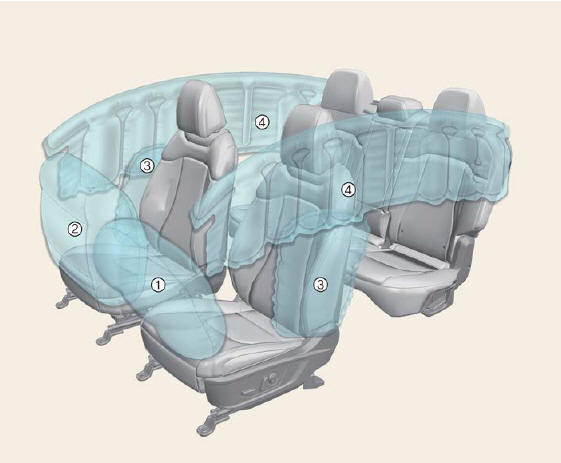Kia Sportage: How does the air bag system operate?

* The actual air bags in the vehicle may differ from the illustration.
- Driver's front air bag
- Passenger's front air bag
- Side air bag
- Curtain air bag
Even in vehicles with air bags, you and your passengers must always wear the safety belts provided in order to minimize the risk and severity of injury in the event of a collision or rollover.
How does the air bag system operate?
- Air bags are activated (able to inflate if necessary) only when the ENGINE START/STOP button has been turned to the ON position.
- The appropriate air bags inflate instantly in the event of a serious frontal collision or side collision in order to help protect the occupants from serious physical injury.
- There is no single speed at which the air bags will inflate. Generally, air bags are designed to inflate based upon the severity of a collision and its direction, etc. Several factors determine whether the sensors produce an electronic deployment / inflation signal.
- Air bags will not deploy in every crash or collision situations. Air bag deployment depends on a number of factors including vehicle speed, angles of impact, and, the density and stiffness of the vehicles or objects which your vehicle hits in the collision. The determining factors are not limited to those mentioned above.
- The front air bags will completely inflate and deflate in an instant. It is virtually impossible for you to see the air bags inflate during an accident. It is much more likely that you will simply see the deflated air bags hanging out of their storage compartments after the collision.
- In addition to inflating in serious side collisions, side and/or curtain air bags will inflate if the sensing system detects a rollover.
- When a rollover is detected, side and/ or curtain airbags will remain inflated longer. This helps provide protection from ejection, especially when used in conjunction with the seat belts.
- In order to help provide protection,
the air bags must inflate rapidly. The
airbag inflates extremely fast between
the occupant and the vehicle structures
before the occupant impacts the
vehicle structures. This speed of inflation
reduces the risk of serious or lifethreatening
injuries and is thus a necessary
part of the air bag design.
However, airbag inflation can also cause injuries which can include fascial abrasions, bruises and broken bones. This is because the rapid inflation also causes the airbags to expand with a great deal of force.
- There are even circumstances under which contact with the steering wheel or passenger air bag can cause fatal injuries, especially if the occupant is positioned excessively close to the steering wheel or passenger air bag.
WARNING
Airbag inflation
Sit as far back as possible from the steering wheel while still maintaining comfortable control of the vehicle. A distance of at least 10 in (25 cm) from your chest to the steering wheel is recommended.
Failure to do so can result in airbag inflation injuries to the driver.
READ NEXT:
 Noise and smoke
Noise and smoke
When inflated, the air bags make a loud
noise and leave smoke and powder in
the air inside the vehicle. This is normal
and is a result of the ignition of the air
bag inflator. After the air bag in
 Supplemental Restraint System (SRS) components
and functions
Supplemental Restraint System (SRS) components
and functions
* The actual position of SRS components
may differ from the illustration.
The SRS consists of the following components:
Driver's front air bag module
Passenger's front air bag modu
 Occupant Detection System (ODS)
Occupant Detection System (ODS)
Your vehicle is equipped with an Occupant
Detection System (ODS) in the front
passenger's seat.
The ODS is
designed to detect the presence
of a properly-seated front passenger
and determin
SEE MORE:
 Side Impact Sensor (SIS)
Side Impact Sensor (SIS)
Description and Operation
Description
Side Impact Sensor (SIS) system consists of two P-SIS which are installed at
each center of the front door module
(LH and RH) and two SIS which are installed at each center pillar nearby (LH and
RH).
Side Pressure Sensor is also called P-SIS beca
 Vehicle lift (2-Support type) and safety stand positions
Vehicle lift (2-Support type) and safety stand positions
1. Place the lift blocks under the support points as shown in the
illustration.
2. Raise the hoist a few inches and rock the vehicle to be sure it is firmly
supported.
3. Raise the hoist to full height to inspect the lift points for secure support.
Jack and safety stand positions
Towin
Content
- Home
- Kia Sportage - Fifth generation (NQ5) - (2022-2026) - Owner's Manual
- Kia Sportage - Second generation (JEKM) (2005-2015) - Body Workshop Manual
- Kia Sportage Third generation (SL) - (2011-2016) - Service and Repair Manual
- Sitemap
- Top articles